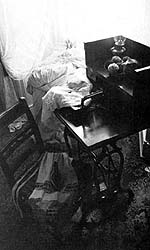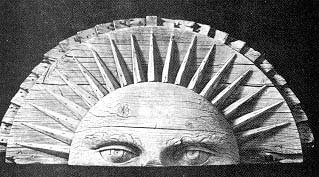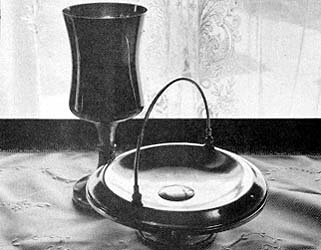“Florence Smith Jacobsen: In Love with Excellence,” Ensign, June 1977, 25–26
Florence Smith Jacobsen:
In Love with Excellence
Sister Florence Smith Jacobsen is a lady in love with excellence. Excellence is a passion that has given purpose and radiance to her life. It has involved her in lovingly restoring the Lion House in Salt Lake City and the Joseph Smith, Sr., home in Palmyra. It motivated the vision of womanhood that helped to shape the YWMIA program during her eleven years as general president. And it has consequently prepared her for her present position as Church curator.
In this position she will help put perspective in the lives of generations growing up now, hungry for their roots, thirsty for an attachment to the past. By collecting, preserving, and displaying the art and artifacts of Church history, she will nourish and strengthen testimonies and inspire some to investigate the restored gospel of Jesus Christ.
For her, love of Church history and love of her family developed simultaneously. She remembers visiting in the home of her great-grandmother, Mary Fielding Smith, awed that the little widow had built her house alone, aided only by her children, young Joseph F. Smith, Martha Ann, and stepson John. “How could you help loving someone with that much courage!” Sister Jacobsen exclaims. And when she was asked by the General Authorities to restore and furnish the Joseph Smith home, it was more than a historical project. She thrilled to sense that Hyrum Smith, her great-grandfather, “had helped build it, had walked up and down the stairs, had sat in the very room I was in.”
Like Mary Fielding and Hyrum Smith, Sister Jacobsen knows the price of excellence. “It means rejecting a great deal of our contemporary culture,” she says, “particularly the pressure to hurry.” It means evaluating and reevaluating. It means constant study. Sometimes it involves the difficult and unpopular duty of criticism. But Sister Jacobsen feels that the rewards are worth it.
“If you’re going to produce anything beautiful—a beautiful dinner, a beautiful building, a beautiful life—it’s going to take time.” She adds with a twinkle, “And you’ll have to accept an unpleasant fact: after the fun of preparing the dinner and the pleasure of sharing it with friends, there are dishes to do.”
She gives some keys to excellence: (1) Plan ahead, even if it means only setting the table the night before. (2) Choose permanence over impermanence everytime you have a choice. (3) Commit yourself to do it the right way. (The old ingrained carpet pattern copied for the Lion House carpet was originally made with seventeen colors and the manufacturer’s largest looms had only twelve. To be able to restore it accurately, Sister Jacobsen negotiated—but did not compromise—and five retired weavers came back to hand-lay the extra colors during the weaving.) (4) Believe in what you’re doing enough to ask others to spend quality time on it (and that meant making the curtains for the Joseph Smith home by hand—every stitch—just as Lucy Mack Smith and her daughters had done).
“I worry a little about how people can learn the right way to do things,” she admits. “We don’t see good models on television, or even in our homes, sometimes. I wish every woman in the Church could discuss ideas with Sister Kimball, or appreciate Sister Romney’s terrific sense of humor, or experience Sister Tanner’s marvelous graciousness as a hostess. Models really are the best way to learn to do things.”
One of Sister Jacobsen’s most important models was her aunt, Lucy Grant Cannon, next-door neighbor, mother of seven, and general president of the YWMIA.
Sister Jacobsen exclaims, “She did everything and did it beautifully: raising her children, presiding over that organization, running the house. I’ve never seen anyone entertain more easily and graciously. And she was always doing things for others like the time she saw a woman in the depot with a sick baby and brought them home between trains, bathed the baby, called a doctor, fed the woman, and washed all their clothes. She always kept a roll of paper in a typewriter in a little alcove and wrote up each day’s events. When my husband was presiding over a mission in the East, I never missed a minute of what was happening at home because of those detailed letters Aunt Lutie sent and I got one every single week!”
When Sister Jacobsen followed in her aunt’s footsteps as YWMIA general president from 1961 to 1972, the ideal of giving Aunt Lutie’s sweetness, spiritual strength, spontaneous service, and efficiency to the Church’s girls helped shape the program of social and cultural activities, spiritual lessons, community service, and camping and homemaking skills. With emphasis on individual achievement, the girls kept personal historical journals; planned, prepared, and conducted annual leadership conferences; set personal goals; met in youth councils with the bishops; were called and set apart to serve in class presidencies; and planned their own activities—all part of the new program for Young Women as well.
At least 150,000 girls, about 30,000 leaders, and no-one-knows-how-many Golden Gleaners have awards signed personally by Sister Jacobsen. They will also remember the Parent and Youth Nights, which were among the earliest programs to focus attention on the family.
One of her secretaries during that time comments, “Those were difficult years to preside over that organization. Loud rock music, modern dancing, miniskirts, long hair, blue jeans—all of them seemed to happen then and there wasn’t a day when she didn’t answer a letter or a phone call on standards. This was in addition to reviewing manuals, festivals, lessons, and activities personally to be sure that everything was presented with the highest standard of excellence. The Personal Record Books won an award for excellent design and were the first step toward personal histories for many women who are now raising their own families.”
Another model of excellence for Sister Jacobsen was her father, Willard Richards Smith. “There were eight of us children, and he had us so organized that the job never got too big for mymother.” Her eyes softened affectionately, “He’d wake us up at six o’clock calling, ‘It’s a beautiful morning! Time to get up.’ And we all knew what we were supposed to do. My job was to dust the living room and dining room and put up lunches for my father, my brothers, and me.”
Another effect of her father’s organization was that it taught all of the children that housework was something to share and be proud of, not something demeaning to be hurried through. “I never saw my mother scrub a floor. My father or my brothers always did. Because my father spent time on our home, it became important to us.”
Pinned down on the hard question of why excellence makes a psychological and spiritual difference, Sister Jacobsen illustrates with a small domestic example.
“I’ve noticed that my four little grandchildren can tell the difference,” she says. “When we do not properly set the table or eat in the kitchen they carelessly seem to forget their table manners. When we eat in the dining room with placemats or a linen tablecloth, they carefully display their best manners. I feel the same way. By treating myself and others as worthy of the best that is possible, I find that people become better. And I feel that this principle carries over into every area, including the way we dress. By making our environment as beautiful and as excellent as possible, we become a more excellent people, mentally, visually, physically, and spiritually.”
This thirst for excellence guides her work as Church curator, which she describes as “all pioneering.” She and her small staff are responsible for collecting, cataloging, preserving, restoring, evaluating, and displaying artifacts that are significantly related to the restoration of the gospel.

The life-style of women in the nineteenth century is represented here by a treadle sewing machine; an iron that is really iron!; a wickerseat chair; and a crocheted pincushion. The photograph was taken in the Beehive House in Salt Lake City.
Much of the collecting is being done by the Stake Historical Arts correspondents called in stakes throughout the United States and Canada. Sister Jacobsen’s eyes light up when she describes their activities: “They’re giving talks in sacrament meetings and firesides and asking members to put their treasures in a safe place. They’re sending us silver sacrament services, family histories, and lovely quilts. One correspondent in Pennsylvania sent us an old map of the United States with Nauvoo on it. On the back is the history of the Church members who owned the map. The husband was baptized there in 1868, and the family stayed in the East, faithful all these years.”
Sister Jacobsen does part of the collecting herself. An airplane seatmate, attracted by her needlepoint, discovered that this Salt Lake housewife was also curator for the Mormon Church and gave her a perfectly preserved blue and white double-weave coverlet, with the date 1838, the family name, the weaver’s name, and the motto “Liberty” running all around the edge—all woven into the coverlet. That coverlet now adorns the master bed in Brigham Young’s winter home in St. George.

Patterned after the sunstones on the Nauvoo Temple, this ornament was part of the temporary tabernacle that stood on the site of the Assembly Hall on Temple Square from 1852 to 1877.
In addition to collecting treasures, Sister Jacobsen is knee-deep in projects to make them available and useful for display. One is a catalog of historic Church buildings. Another is an illustrated catalog of all Church-owned art: bas-reliefs, stained glass windows, chapel murals, items in visitors’ centers and mission residences and offices, and all other art and artifacts. The Curator’s Office has prepared and loaned a collection to the Smithsonian; a second collection is on a four-year tour of United States and European museums under the auspices of the Boston Museum of Fine Arts. The Curator’s Office is also beginning an art restoration project jointly with Brigham Young University.
But the kingpin in the curator’s complex of future plans to have our history concrete is a new museum of Mormon history and art designed to give members of the Church experiences with their heritage. It is planned to have visitors touch the cannon hauled across the plains. The same Palmyra printing press on which the Book of Mormon was printed will be restored and operating—turning out freshly inked sheets bearing the testimonies of the eight witnesses. The odometer that measured distance across the plains will be ticking away on a revolving wagon wheel. Automobile-conditioned Mormons can test their mettle by pulling a hand-cart, fashioned according to Brigham Young’s directions and laden with the items he told the Saints to pack.
Says Sister Jacobsen: “We want members to see in the Church museum artifacts that reaffirm that the gospel has been restored. We want to enlarge the testimonies of members with the art and artifacts that were part of the Restoration and develop the desire in nonmembers to know more. Everyone who joins the Church inherits a marvelous history—even if he’s the first in his family. Everyone deserves experience with that inheritance.”

A sacrament tray and cup from the nineteenth century.
A long-range goal is to expand the Historic Sites program overseas; markers are already in place in England at the sites of the first baptism, the first sermon, and the place where an entire community was converted.
Does this program sound ambitious for a four-times grandmother? There’s more! Sister Jacobsen also serves on the governor’s committee for cultural and historical sites, and has just finished a two-year term as third vice-president for the National Council of Women and is now chairman of the Child and Family Committee. She’s also adviser to the executive committee, adviser to the financial committee, and is serving a three-year term as vice-treasurer of the International Council of Women—an organization that has great impact on social and community action programs through its influence on legislatures and state boards of education. As chairman of the National Council of Women’s Child and Family Committee from 1965 to 1972, she represented the United States at four international conferences. These conferences have, in turn, presented plans to national councils, and she recalls that one of her greatest thrills was “putting a fence at the top of the cliff instead of an ambulance down in the valley.” The majority of the delegates seemed to be in favor of recommending paid-maternity leave and full day-care facilities for working mothers. She opted for a program of teaching responsible parenthood that would begin in the home and be carried on in elementary school and throughout a person’s educational life. Here was a clear choice between a long-range program that would demand years in the interests of excellence rather than a short-term program that would demand an influx of funds for its immediate results. Her program passed. The United States Department of Health, Education, and Welfare has already implemented trial programs on responsible parenthood in selected grade schools—“with great success.”
She counts as one of her special blessings on the National Council of Women her association with Sister Belle Spafford. Both of them were delegates during the times that they served as general presidents, Sister Spafford of the Relief Society and Sister Jacobsen of the YWMIA. “She taught me to find solutions to problems by evaluating the pros and cons carefully before making a decision. She has become one of my dearest, wisest, and most beloved friends, whom I cherish and depend on because of her great understanding and experience.”
Her commitment to community service extends to serving on the advisory council of the Family Living and Consumer Studies department of her alma mater, the University of Utah, and writing vigorous letters protesting television programs and magazine articles she doesn’t approve of.
The mention of today’s shibboleth for women, “fulfillment,” brings instant response. “No woman—and no man either—can fulfill herself by focusing first on her own needs. Serving others fulfills you by making a bond between you and them that you can’t duplicate any other way.”
She shares the way she learned this lesson. “I had a Junior Gleaner in my MIA class who simply wasn’t attending. Her parents were dead and she lived with an aunt who told me she might feel self-conscious about her clothes, so my marvelous husband decided that our Christmas presents for each other that year would be a wardrobe for this girl—dresses, a nightgown, robe, shoes, coat, everything. We left them wrapped on her doorstep on Christmas Eve, and I kept phoning her as I had every week to say, ‘We missed you at MIA. Your seat was empty.’
“She did come back to Church occasionally, but she married young and moved away. I never knew what happened to her until one June conference when a MIA Maid teacher in California wrote and asked if she could bring her class to meet me after June Conference. It was my girl! And every single member of her class was there. She said, ‘I got them the way you got me—by missing them and letting them know it.’
“But what really touched me was that I’d always felt close to her, even through all those years when I didn’t know where she was. The kind of doing, sharing, and concern that I’d felt for her had made a bond that had lasted that long.”
She adds, “And you see, it was the Church that gave me the opportunity to learn that lesson. The Church has taught me many lessons in excellence. When I think of how the Church has brought me the friends that are most precious, the experiences that are most dear, I can only feel how empty my life would have been without it and how full and wonderful my life has been because of it.”
Photography by Eldon Linschoten and Craig Law
Artifacts from the Church Curator’s Department include a cape worn by Joseph Smith; a top hat that belonged to Brigham Young; a vest of Hyrum Smith’s; and the watch that saved John Taylor’s life by stopping a bullet in Carthage Jail.